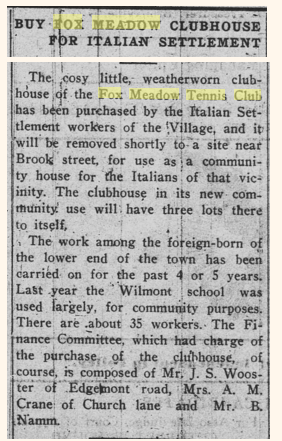Difficult financial times for the Club.
J. Nelson Shreve elected FMTC President (1914-1915); articles of incorporation filed, a portable clubhouse installed, purchase of Wayside Cottage considered
The period after 1913 appears to have been financially precarious, as neighboring clubs built and upgraded their facilities. The Scarsdale Golf Club built tennis courts in 1911, and in 1912 the County Tennis Club in Hartsdale constructed a clubhouse. Both events apparently lured some members and potential members from Fox Meadow.
The Club’s treasurer wrote endless letters dunning people for lapsed dues and asking payment for such items as tennis balls. (New balls were forty cents each, used balls twenty-five cents.) The Club’s treasury did not cover all costs, as is indicated by the following letter from Herbert B. Shronk concerning a $45 bill for trophies: “As the Club now has in its treasury only about $10, it will be necessary to make up the sum by subscription. I understand the necessary funds were pledged by Messrs. Ayres, Aspinwall, you [J. Nelson Shreve], and myself. …”
To offset a deficit in 1913, the Club raised dues for new members from $5 to $7.50 for individuals, and from $10 to $15 for families. [2014 Dues Notice] The increase was apparently too stiff, for dues were reduced in 1917.
The earliest surviving membership list, dated 1914, showed several names from the formative years, including Alex Crane, Hopeton Atterbury, and Miss E. Popham. New members included Frank Ayres, whose family would play an important role during the Club’s middle decades. Fox Meadow had forty-nine family members in 1915, with an additional forty-five individual members.
Groundskeeper Ira Jones worked a six-day week during the tennis season for $60 a month. In season, deliveries of ice and water arrived regularly at the Club, which as yet had no building other than a storage shed donated in 1902 by Hopeton Atterbury.
Hours available for play must have been extended around 1914, for the organist and musical director of the Church of St. Mary the Virgin wrote the following letter: “I desire to withdraw from the Fox Meadow Tennis Club as I do not approve of the Club courts’ being open on Sundays during the hours of Public Worship. Yours very truly, Walter Fleming.”
There were four committees in 1915: an Admissions Committee chaired by Vera Quaid Ayres, a Grounds Committee chaired by Hugh White, a Tournament Committee chaired by Pliny Williamson, and a House Committee chaired by Mrs. John Carstensen.
The Club took three major steps in 1915. It filed articles of incorporation, installed a portable clubhouse for $400, and launched a major drive to raise funds to buy a permanent home. [See also Letter to Membership seeking input on future development of the club] None of these ventures went off smoothly. In later years members of the Board of Governors referred to the Club as a non-incorporated entity, apparently because records were lost or memories faded.
During the same year, the board apparently hoped to buy Wayside Cottage and its adjoining land. Unfortunately, a gap of more than a year in the Club’s minutes makes it impossible to reconstruct exactly what transpired. Many decisions involving Fox Meadow Tennis Club were made at informal lunches in Manhattan clubs, so no official notes were taken.
The third step taken in 1915 was that Frederick L. Collins proposed a plan for “raising the remaining subscriptions for the Fox Meadow Club.” He called for a notice stating “that it has become necessary to give up the present club and to form a new one to be called the Fox Meadow Club, which will purchase and operate the Wayside Cottage property; that almost all the funds necessary for this purpose have already been subscribed.”
At least $4,000 had been pledged, but for unexplained reasons the effort to buy Wayside failed. Emily Butler ultimately gave the property to the Village for use by the Scarsdale Woman’s Club.
The little clubhouse bought in 1915 was another failure. In 1916 it was sold at a loss, evidently because the Butlers objected to the structure and insisted upon its removal. The Inquirer reported, “The cozy little weatherworn clubhouse of the Fox Meadow Tennis Club has been purchased by the Italian settlement workers at the Village, and it will be removed shortly to a site near Brook Street for use as a community house for the Italians of that vicinity.”
Source: Diana Reische, Fox Meadow Tennis Club – The First Hundred Years, 1983






